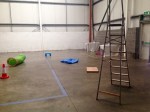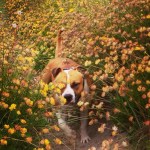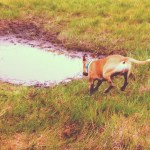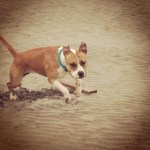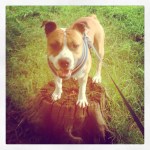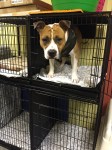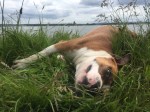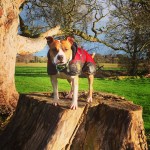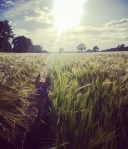Welcome to Day 22 of #100daysofenrichment and thank you for joining us on this journey!
Although our challenges are directed mainly at dogs, we want all species to enjoy and benefit from #100daysofenrichment so, please join in, adjust and adapt to help your pet or companion live a more enriched life.
Don’t forget to review all the information leading up to #100daysofenrichment and more here on playing safe. Know your dog!

Confidence Courses
At a glance:
- taking cavaletti another step forward to provide a more involving and engaging activity
- just as the name suggests, confidence courses should be designed to facilitate the development of confidence through choice, body awareness and environmental interaction
- cognitive and sensory based enrichment
- often used in training for sports dogs and for rehab after injury, trauma or surgery and particularly beneficial for puppies
Puppies need help developing their startle-recovery response. Exposure to mild, manageable startle primes their developing stress systems to engage and relax. This contributes to resilience. - get the family involved in this one – kids love setting up challenges like this for their pets. It’s probably better than an adult to help the dog move over the obstacles though as this requires a level of care and coordination, particularly at the beginning.
Remember, supervise children in all enrichment activities and interactions with pets. - practice in very short sessions of 2-5 minutes at a time – this can be very tiring, both mentally and physically, so it’s important that you work for very short sessions
What do you need?
- cavaletti stuff – you can add cavaletti to this challenge if you like
That’s a great way to revise if you and your pet enjoyed it, and a great way to introduce new challenge with some familiarity for your pet.
- cushions, dog beds
- blankets, towels, sheets, Vet Bed
- sheets of different materials, e.g. tin foil, flattened cardboard box, tarpaulin, plastic sheeting
- tables, chairs, stools
- shallow plastic tub or lid
- hula hoops, pool noodles, cones
You might have some so-called canine conditioning equipment which often includes various inflatable tools, or wobble boards, for example. Don’t worry if you don’t have them, we can make & do!
- food rewards – it’s better to use soft food rewards for this one so that they don’t roll on the floor too much, which is important for these challenges
Enrichment Goals:
- to help dogs develop awareness of how their body moves, where their limbs are and how to adjust and shift their weight to compensate during physical challenge
- to boost confidence through safe environmental interaction
- to provide physical and mental challenge to pet dogs
- to encourage dogs to interact with novel or weird things in their environment
- to help dogs develop confidence through enhanced body awareness
- to help dogs slow down and think about how they move and physically interact with their environment
- to help prevent injury, improve fitness, lengthen stride, increase back and core strength
Confidence courses should aim to acheive some of the same goals as discussed with cavaletti such as improving propioception, strength, balance and so on.
But, they should also help to encourage dogs to investigate, approach and interact with weird or new environmental features.
While this challenge is certainly cognitive, the dogs are also experiencing sensory challenge and we are adding enrichment to their environment, with lots of crossover between categories.
Our main application of confidence courses is with puppies, whose brains are forming resulting in improving coordination as the relevant brain areas mature, and whose startle systems are maturing, so exposing them to manageable and minor stressors, that they can overcome, is important to help them develop resilience.
Shy and older dogs can be particularly helped; they are learning to interact with their environment, being exposed to novel stimuli and sensory experiences, and engaging their cognitive and sensory systems…the world can be challenging but you have skills to cope!
What goals can you add to this list for your pets?
How can we achieve these goals?
- take your time with this one and listen carefully to your pet
- set up your confidence course without your dog; allow them to enter and investigate first, before you do anything else – they get to decide how much they interact or participate
NO food and NO luring – just let them take their time and check it out. - if there is to be physical movement especially, set up in a non-slip area and use non-slip substrates onto which your pet must step
- this is not a race – the goal here is to help the dog move slowly, gathering information, considering how they wish to proceed, how they place each foot and compensate for different challenges
- work with your dog on lead if required to help them move a little slower but don’t use lead pressure, otherwise they will need to further compensate
What adjustments will you make for your pets?

No Luring!
Luring is applied when you hold a motivator, such as a treat or a toy, right at your dog’s nose to encourage them to move or position.
You are essentially luring when you toss a motivator in the direction or location in which you wish the animal to move, but it’s probably not as pressurised as there’s less social pressure, less looming, less coercion.
Luring is not evil, even though I often go on as if it is, and it has its place in animal training, but, there are times when luring really isn’t a good idea.
Luring diminishes the dog’s choice. They may want the food but not the interaction with a person, other animal or item.
Just because you’re using a food reward that the dog likes, doesn’t mean that what you are doing is without force. It’s just a different kind of coercion.
And just because the animal eats the food, doesn’t mean they are having a nice time, that you are positively reinforcing the behaviour you think you are, nor that you are establishing positive CERs.
When we are looking to encourage the dog to interact with something novel, scary, arousing, luring them is going to mean that they have less choice, that they might experience internal conflict (and related behaviour) and that they might be forming less than positive associations with the item, you and the training scenario.
I will pretty much avoid luring when working with fearful, cautious, unfamiliar dogs and really for me, it’s often one of my last go-tos for teaching behaviours in many circumstances.
So, when attempting to build a positive CER to something and when boosting confidence, luring might not be the place to go. We want the dog to take in the environmental information, take their time to make decisions, without the social pressure from their human and without the temptation of the food, masking all that learning and choosing.
Of course luring can be used in thoughtful and effective ways to get behaviour and the positive emotions behind it, but it’s not for this particular challenge.
When can we use food?
We can still use food for our confidence course, but in a less pressurised manner so that choice in exploration is emphasised.
Try introducing food at an appropriate level for your dog. We don’t want food to mask their experience and exploration and we certainly don’t want to coerce (lure) them with food if they are cautious or reluctant to interact with obstacles.
Break down the challenge to help the individual dog; here’s a nice clip of a puppy, from class, called Toby, with a crate – the point is not to crate/confinement train, at this stage any way.
We are just working on stepping over a lip, stepping on to something slightly unstable, stepping into confinement…lots of big leaps for this cautious guy.
Can you spot the adjustments we make to help him grow in comfort and confidence?
Novice dogs who tend toward caution, shyness or reluctance:
- set up your confidence course without your pet present – this encourages exploration of the novel setup and avoids spooking a sensitive pet with moving or presentation or weird things
- stand back and allow your pet investigate – don’t do or say anything, just allow them to enter and take stock of the confidence course set-up. This takes as long as it takes. Give them time to decide how much they interact or not.
- Toss food on or around each obstacle so that your dog can find it, by surprise, and interact with the obstacle naturally, rather than in some contrived sequence.
You might even consider a scatter feeding type addition to your course.
Just doing that much is great and repeating that a little will encourage lots of exploration and interaction, plus builds confidence.
Novice dogs who are pretty comfortable or quick to recover from caution:
After exploration, remove your pet and re-organise the course or add new obstacles.
Repeat the Beginners steps and work through again.
A more confident model along with being engaged in other activities, such as play with a buddy, can help a more cautious individual become more confident among the obstacles because they are experiencing it all in a more natural, less contrived way. This might also be an option for shier dogs, who have a more confident buddy for help and support.
Dogs comfortable and interested in novelty:
Where your dog is happily, willingly and without hesitation or reluctance interacting with each obstacle, begin to lead them through in some sequence.
If you’ve been practicing your targeting, using a hand target, target stick or a visual target to move the dog through the obstacles may also help.
Toss food ahead to encourage them to move out and interact with each obstacle. Take your time, it’s still not a race!
Applications of Confidence Courses:
Confidence courses allow for multi-sensory experiences, drawing physical, cognitive and sensory challenges, and when presented appropriately, encourages the practicing of lots and lots of good stress.
Just as with cavaletti, confidence courses help dogs who experience swings in arousal by helping them develop strategies (behaviours) for coping with the world. They learn that they can overcome challenge, that what they do matters, and that they have some control over what happens them.
We teach them that they can interact with weird or novel things in their own time and in their own way, that novelty and weirdness are challenges that can be met, and they can use their behaviour to deal with it.
Enrichment Options
Construct your confidence course so as to introduce different challenges so that it become a multi-sensory journey for your dog, of exploration and confidence boosting.
Choose one obstacle from each category and for more enrichment-bang-for-your-buck, choose obstacles that cover more than on category.
We want to encourage stepping on, over and under things, sniffing and manipulating and going on a bit of a sensory journey.
Catergory 1: Visual

- big things
- novel things – things that your dog hasn’t interacted with up-close
- familiar things, presented in a new way for example, placed in a new location or position such as turning a chair on its side
- open umbrella
- reflective things like mirrors or tin foil sheets
- illuminated things like toys that flash or sparkle (no laser lights or other things that cast shadows or reflections)
Category 2: Auditory

- crinkly things like paper bags, IKEA bags, newspaper, bubblewrap, plastic sheeting, tarpaulin
- lay a blanket or towel over crinkly things to change the sound and texture
- waterproof type bedding, human rain gear laid out
- keyboards, that can be stood on, music or sound making toys – things that the dog can turn on or off (must be about choosing exposure)
Category 3: Propioception & Balance

- cavaletti
- wobbly things: wobble boards, balance discs and pods, inflatable conditioning equipment such as FitPAWS or TotoFit
If you are using human balance discs and similar, make sure you get ones that don’t pop! - home-made wobbly things: lay a blanket over some cushions or pillows piled, lay a board over a cushion and top with a blanket, lay a plank over a length of PVC pipe for a makeshift see-saw
Add height:
- steps and stairs
- different levels
- up on low coffee tables or patio furniture
- on and off the sofa or chairs
Category 4: Under & Over

- get dogs ducking under chairs, tables, hedgerows
- lay a blanket or streamers over a chair or table for your dog to move under
- use a tunnel or other children’s play furniture
Category 5: Feeling & Texture
- choose nobbly or prickly things such as different doormats, fake grass
- put a towel or blanket into the fridge or on the radiator for 20 minutes and lay out and investigation
- areas that require walking on different substrates such as gravel, mud, sand, concrete, carpet, slick flooring
- areas that offer different gradients such as steep, stairs, climbing
- add an inch or two of water to a shallow tray or plastic tub
Puddles are a nice introduction to water, and even just walking through shallow water encourages cognitive challenge.
Category 6: Scent
- food rewards
- sniffing the obstacles, especially if they’re novel items
- incorporating natural smellies such as branches, grasses, foliage
Category 7: Taste
- novel foods
- deconstructed dog food:
Have you watched Master Chef? Almost every episode will include some deconstructed staple; regular favourites including lasagna and cheesecake (yum!). Each component is separated out presumably providing the diner with new flavour, texture and sensory experiences, with every mouthful combination.
Let’s try with our dogs. Instead of mixing ingredients in home-prepared diets or treat mixes, lay out each component for your dog to sample individually and choose, or not.
If you feed a commercially prepared diet, take a look at some of the ingredients. Maybe there’s chicken, rice, egg and apple in the food, for example.
Try preparing some of each of the main components and present them in separate little piles in a bowl, dotted along the floor or on a tray or chopping board. Observe your dog’s responses to each component and allow them to choose which ingredients they like.
Category 8: Manipulation
Add things that require your dog to manipulate them in some way:
- stuffables that require holding, lapping, chewing
- suspended stuffables which increase the challenge in using their mouth to manipulate
- teasers so that the dog must move something out of the way to get the goal
- snuffle mat or snuffle puzzle
Maybe it’s a toy they play with, hold, carry or tug – it all adds another dimension to the course.
Confidence Course Challenges
Beginners:
Set up a cavaletti course or other things that your dog is already familiar with, and add one or two other obstacles from other categories.
Intermediate:
Start with familiar items and experiences, and add more novel items from different categories.
Switch around the course each time your dog has a go.
Advanced:
Construct confidence courses that incorporate as many different categories of challenge as available. Switch them around, add and subtract all to keep the experiences exciting and novel.
Agility Anywhere
Confidence courses don’t just have to be set up indoors, in controlled environments and contrived by humans.
Adventure Walks are especially beneficial for puppies, who are just learning about the world, but all dogs will benefit from appropriate exposure to sensory and physical challenge. Here are some puppies on their Adventure walks: Biggie, Tenzing & Blue.
Let the dog explore and interact with their environment, without too much interference from the humans. Use food rewards sparingly and only once comfort has been established:
Think about places you can take your dog so that they can experience these categories of challenges as they naturally occur.
Wooded areas, parkland of different aspects and substrates, even urban and suburban areas offer lots of variety, from different sounds, smells and substrates, to physical and propioception challenges that require climbing, jumping, ducking and balancing.
Body awareness work is very tiring for dogs because it is such exerting physical and mental exercise. Just like a good Sniffathon, you might be surprised just how tiring your dog will find these exercises.
Practice in short sessions of just a few minutes at a time. As you notice your dog becoming more clumsy, that’s a good indication that they are tiring, mentally and physically. The dog might knock things, might attempt to jump or rush obstacles, or might show reluctance to engage with the items.
Listen to your dog and let them go at their own pace. Slow and steady wins the race!
Your challenge
Now it’s your turn. Show us what you and your pets, of any species, can do with these challenges!
Post to your social media accounts, using the #100daysofenrichment so that we can find you and join our Facebook group to share your experiences, ideas and fun!
You can comment right here too 🙂
We look forward to hearing from you and your pets – have fun & brain games!







